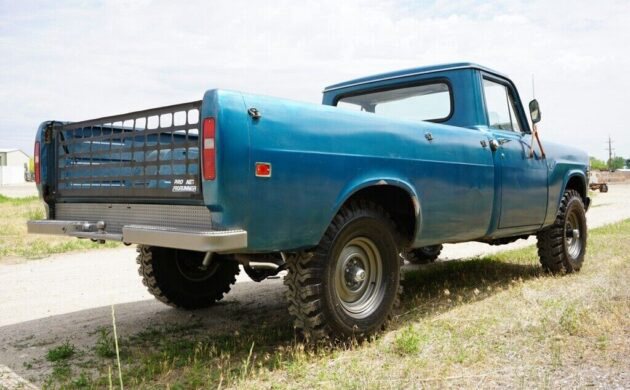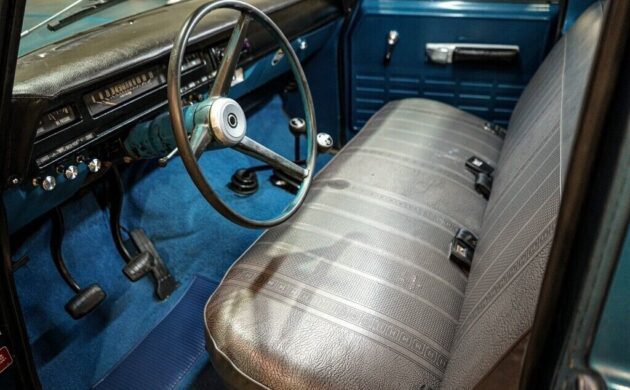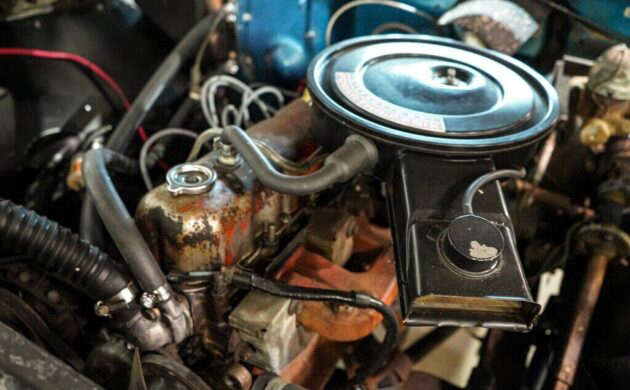Let’s get one thing straight: in order to differentiate its farm machinery from its light trucks, International Harvester ditched the “Harvester” portion of its name, calling its trucks simply “International”. IH fans still affectionately refer to most of its products as “binders”, pertaining to the corn harvesting activity of its tractors. So decades after its brand name has faded away, IH remains tied as tightly to its agricultural roots as ever, despite making light trucks since 1907 and heavy-duty trucks for almost as long. Keeping the nomenclature in mind, we’ll note the seller of this half-ton 4X4 1972 International 1110 here on eBay should be forgiven for adding “Harvester” to his listing- nearly everyone does! And it’s a fine truck, bid to only $8100, no reserve, located in Caldwell, Idaho.
By the 1960s, competition with the Big Three was demonstrably stealing sales from IH, leading to a complete refresh of its Light Line in 1969. The new design was dubbed the “Now” look, and it echoed the clean, uncluttered lines of the Scout. The bed’s straight sides made for easy loading and double-wall construction protected outside sheet metal if cargo shifted. In 1971 grilles were made of plastic – not in keeping with the tough reputation of IH – so in ’72, the grille was once again made of metal, now incorporating five horizontal bars with a center divider. The no-nonsense look matched IH’s reputation as a hard-working, long-lasting truck. This example has new tires and comes with its original line setting ticket as well as an owner’s manual.
By the 1960s, IH was struggling. It had several lines of business which fostered internal conflict, an underdeveloped dealer network for its passenger vehicles, and it completely missed the trend to comfort that Chev and Ford were riding to record truck sales. The 1110’s interior corrected this, with improved seats, better instrumentation, and several interior trim packages. This truck has a deluxe package with fancy brightwork.
IH offered several motors, some of its own and some from AMC. This truck has an AMC 258 cu. in. in-line six-cylinder good for about 115 net hp. It’s got plenty of torque, too. A four-speed manual floor shift and a TC-142 two-speed transfer case put the power to the wheels. The 1110 has I-beam suspension, while its sibling – the 1010 – has torsion-bar suspension. Take a minute to peruse the undercarriage photos – as respectable as the rest of the truck may be, the underside is a work of art. Given the condition of this 1110, I’m tempted to say the price as it sits is a bargain. What do you think?






Put a Jeep FI six in there to wake things up. Few are gonna care that it’s not original – if the buyer thinks otherwise, keep the old six for future sales.
Those trucks were tough – to work. They didn’t resist the tinworm well, though. The DPW I worked at had an International pickup – one, the foreman’s truck. They favored Chevrolet trucks, but for some reason he leaned on them to get an IH 4×4 as the supervisor’s truck. With a plow on it, so he could clean up and assist in snow emergencies.
It was a 1973. By 1977 the bed was literally falling apart, and had to have braces welded. Including the tailgate, which was welded up. The corners behind the seat were gone.
But, the paint was still nice and shiny.
Just know what you’re buying, here. For work settings, you can’t go wrong. If you’re gonna use it as a winter sled…fuhgeddabahtit.
The armstrong steering which stopped my wife from driving my ’57.
In the late 70’s my older brother bought a 74 1100 4X4 It was a V8 automatic. Did not get around well in the snow or the mud for that matter. What I thought was pretty neat about it was the divorced transfer case. The motor was also very weak
Hmm my 1300d 4×4 definitely is better ride and better in sno than any my dad’s 1st generation dodge cummins and yet 67k on it great 4 rock firewood and heavy haul as it is a 1.25 ton w Lil 304 key with ihc is run them on tq not rpm slow high tq moters as I have owned 7 of them 1962 to 1973 all out pull any of big 3 any day
International is an old and still existing name in heavy trucks, although now sharing step parents with Volkswagen, kinda like somebody else we know. But years ago, from the American city of Chicago, International, besides everything else, built some great pickups, tough as nails, and for many years, they were #3, ahead of Dodge. The last generation, and last gasp, came in 69, and not a particular good one in my opinion, still a good powertrain, but zero styling. Unfortunately, 75 marked the end of an era. And really, International had much bigger fish to fry, than to mess with the light truck market.
Unfocused. International Harvester wanted to be everything to everybody…who was rural. They wanted to be Case and Tractor Supply and Ford, all at once. International Harvester once planned their dealers to become rural retail centers, selling appliances and supplies (there are International-branded refrigerators out there, still) and pickups and “suburbans” and tractors…and for the city farmer, the Cub tractor, later the Cub Cadette and lawn attachments. This on TOP of their traditional business making tractors and harvesters.
Well, you can guess what happened, if you don’t know. Try to do everything, and you do nothing well. International tractors and farm implements faced competition, and they kept up. But roadgoing vehicles faced another form of competition, from the Big Three plus Kaiser and Studebaker…and IH dealers, not on board with the Tractor-Supply retail model…found the pickups and Travelall and Scout an unwelcome distraction. The appliance business was sold off, without the name. After the A Series pickup was launched, 1957…which was, at the time, as modern as any, at the time…the line stagnated. The company had money and labor troubles, and Federal safety and emissions regulations loomed.
It took until 1970 to fully move away from wraparound windshields and the cab of the A body (in fairness it was modified a bit with the B and C derivatives) but the result shows the corner-cutting. The cab of this last series, is not ergonomic. Many, many times I’d cracked my head getting into my boss’s 1973. It was not for the long of leg, IIRC.
The use of AMC engines also shows a come-down…International was always proud of their heavy-truck-proven engines used in pickups. But the truck market, too, was changing – they’d gone diesel, and the power for the big IH products was Detroit Diesel, or Cat or Cummins. There was not the money to upgrade and de-smog the old gas IH engines; so they turned to another beleagued independent, AMC (by this time a competitor, with their Jeep J trucks) to get certified engines.
Yup, the end was in sight. The “bigger fish” was to keep the company solvent, any way possible. In the end, it meant exiting the pickup/utility-wagon market, and then, as the buzzards circled overhead, selling the tractor and equipment lines and designs to Case. Heavy trucks seemed to be the growth market, and newly-renamed Navistar chose to focus on that.
It kept the company going for 40 more years before winding up a Volkswagen property, so I guess there’s something to be said for that strategy. It’s a happier ending than Studebaker or even Jeep, has had.
You are so right they were into heavy trucks and medium duty also big time they made some really good ones I think with the VW Traton there heavy duty division will maybe help Navastar International
I had a 65 scout with a slant 4 cylinder engine tough strong plenty of torque and great in the swamp.
Good commentary JustPassinThru 👍
Check the VIN tag clearly says international harvester..
Yes. An International pickup- made by International Harvester.
I didn’t realize it was a mystery, but I’m certainly relieved you solved it. Lol
“Corn binders, hay balers, poop spreaders”, even refrigerators,( yes, they had a home appliance line), all silly terms to describe the best trucks America had to offer. A hefty claim, but if my past has any merit to anyone, you’ll take it as fact. In my trucking career( 40 years, almost to the day), I drove more IHs than any other truck. It was a matter of economics, no other truck provided such great service, and companies had fleets of them. From Loadstars, to Transtars, it was a name we could count on, and kept America humming, many Detroit powered, so literally humming.
The light duty line was not near as successful, and catered mostly to the farm community. Farmers could get parts for the combine and the pickup. Fact is, I remember, IH parts were not unlike foreign cars, and many parts places didn’t carry them. Sounds like a plan, no? One problem. Farmers usually only bought one combine, one poop spreader, and yes, one pickup. Realizing that, IH pulled out of the light truck line in 1974( Scout until 1980) to concentrate on the HD truck biz, that was going great guns. In 1986, however, a new kid on the block, Volvo, that initially had an identity crisis, marketed as White/Volvo/GMC, later just Volvo, decimated IHs HD truck market, and never recovered to it’s former glory. There was a reason IH used AMC motors, the 392,( no relation to hemi) IHs most popular motor, was in short supply, and since IH didn’t offer their own 6, AMC was more than happy to step up to the plate. It turned out to be a poor decision, as most farmers wanted the IH V8, and for good reason, they powered every school bus in the country for a reason, hence, its shortage.
It’s a great find, certainly not many like this. Considering where light trucks went, a colossal blunder on IHs part.
Good historical summary JustPassinThru. I like these year Internationals, for their squared-off styling and no-nonsense interiors. Just check out the simple rectangular gauges and the basic steering wheel and the heavy duty shifter. Now, contrast that with (for example) the restyled 1973 F-100 in Ranger XLT trim. The light truck market was beginning to change and, in hindsight, International didn’t (or couldn’t) keep up.
Another nice truck from this ebay seller.
Thanks. But my long-winded addition to the first comment…disappeared.
That seems to happen, time to time.
Nice-looking rig. I bet those Military tires are plenty noisy on the road. I guess the tailgate has gone missing, replaced by the plastic “net” that was a popular thing in the 80s. The idea was that the net would allow the wind to pass through the holes at highway speeds, giving less wind resistance than a steel tailgate, plus the reduction in weight would give better mpg. Actual tests showed little if any difference.
Had a ‘72 1010 wagon. In gas chamber green metallic. What a sturdy towing beast! A little homely, but reliable.
A company I worked in for from 1976 to 1980 owned a 1972 (INTNL) V8 4 speed 4X4. I drove it in every every inclement type of Massachusetts weather including the aftermath of the blizzard of 1978 no problems with traction anywhere , no chains needed locking manual hubs they all had the same. Back then as a 24 year old, I cared nothing about what parts in the driveline that may or not bee divorced from whatever other parts. That thing was a true work horse it was Spartan to the max, no air no plush carpet ,am.fm mono, armstrong power windows, certainly not the gussied up ladies of the night pick up trucks rolling around today. Nobody assigned to it, on any given day feared using it hard because it could take it , day in a day out . That truck was an unstoppable beast compared to the Chevys or Fords owned by the same company, a truck made to be worked not pampered and one that unfortunately no manufacturer makes anymore , too simple too easy to maintain, and not pretty enough to spare it a daily flogging.
I agree these trucks are work horses and I have a 1971 1310 one ton 4×4 and have had it the family for 16 years and no rust and only 52,000
Miles on it and the only thing I have done is built a custom flat bed and put a 2″ lift to accommodate the 36″ monster tires.
Rare 4X4! 1972 International 1110 Pickup . . . even more rare would be a crew-cab version of this generation of IH pickup.
I agree with Howard A to a point, but it was Freightliner that put the hurt on IH, but Volvo didn’t do them any favors, either. I have driven several IH gas burners, they were tough work trucks. Ford even partnered with IH later on to develop their 7.3 diesels for their pickups, then screwed IH out of the deal.
Markets change, and IH didn’t or couldn’t change fast enough in the light truck market, so they got out of it. Right now I see an opening for a simple work truck again, but it’s doubtful IH will take the chance. They have lost so much money in the heavy market the last few years they are on shaky ground. Their troublesome Maxx Force diesel engines were ultra failures and almost put them out of business. Nothing like the earlier IH, which served its target sales fine.
Ford didn’t screw International out of anything. International started building bad motors, so Ford took over, and began building them in-house. Ford was International’s bread and butter for many years.
Nice truck, overall. You could park it on my driveway. I was never too fussy about the AMC engine under the hood but IH’s six could no longer meet emissions and since the six wasn’t as popular as the V-8 Binder opted for the AMC. As far as the V-8 was concerned the AMC 401 was OK but it wasn’t a Binder.
International’s woes actually go back to the Dirty Thirties when the depression screwed up everything. Like many other companies IH tried to keep on a brave face and try to tell all its shareholders that times were OK, and with all of that the generous dividends kept coming. Binder soldiered on but what it should’ve done was to reinvest in itself and prepare for a time 40 years in the future. The 70s came and with it a demand for farm equipment and trucks that no one had ever seen before or since. Trouble was the companies that kept investing in themselves were able to increase production in an attempt to keep pace with the demand but Binder was still operating with Pulley-And-Jackshaft factories that dated back to the teens. When it realized that it needed to level the old buildings and build new ones it was hit with 20% interest rates. Add to that, ridiculous lawsuits (for leaky off-road fuel filler caps) and a couple of strikes, and Binder was striking out.
It sold off its agricultural and industrial divisions and formed Navistar International for the trucks. Of course by then the light line was over, even for Scout. But those were a result of tension between the divisions; the larger truck line didn’t want anything to do with the light line so it kind of bullied the light line out. It was a real tragedy.
However, IH trucks are making a comeback. There’s no telling what would’ve happened if they had kept the light line afloat…
The Scout name is coming back. VW of all companies secured that name to build an electric Scout.
Yes, the Scout “Electrolux.” First glimpse of this and I can’t help but think what a neat ride with a Cummins V-6 under the hood. But Europe is still in the EV fantasy so the powers at VW won’t consider it…
Painful ..